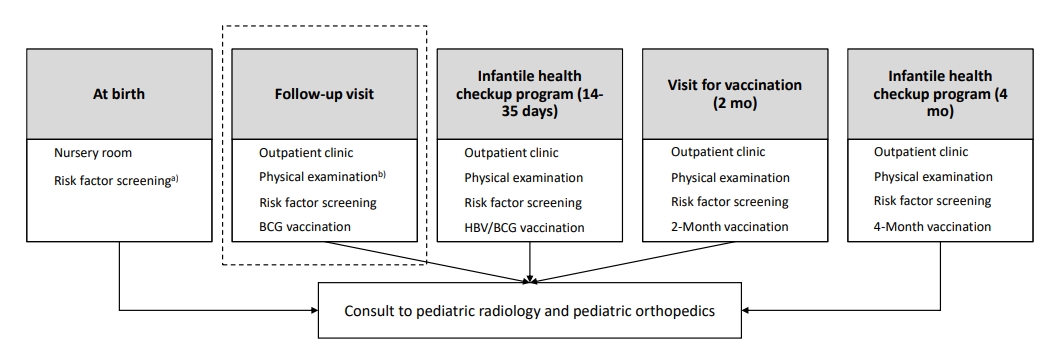Most downloaded
- Page Path
-
- HOME
- BROWSE ARTICLES
- Most downloaded
"Most downloaded" Articles are from the articles published in 2022 during the last six months.
- Editorial
- Neonatology (Perinatology)
- Ideal timing for aggressive screening to detect developmental dysplasia of the hip in term and preterm infants
(4 times)
-
Won-Ho Hahn
-
Clin Exp Pediatr. 2022;65(7):346-347. Published online March 14, 2022
-

|
The risk factors and pathogenesis of developmental dysplasia of the hip (DDH) are unclear. Moreover, no universal screening method can entirely eliminate the risk of DDH. However, its incidence is significant and its early detection is critical for improving patient prognosis. Although the ideal evaluation time and risk factors, especially for premature infants, are unclear, the necessity for DDH screening programs for term and preterm infants is emerging. |
-
-
- Allergy
- Clinical considerations and practical issues of allergic diseases in COVID-19 era
(4 times)
-
Sungsu Jung
-
Clin Exp Pediatr. 2022;65(12):587-588. Published online November 29, 2022
-

|
The risk of sudden acute respiratory syndrome coronavirus 2 infection and severe coronavirus disease 2019 (COVID-19) outcomes is not elevated in patients with the type 2 phenotype and well-controlled asthma. Inhaled corticosteroids, intranasal corticosteroids, and topical steroids can be safely used in COVID-19 patients. Biologics can be safely used by patients with allergic diseases without concern about antibody responses. |
-
-
- Endocrinology
- Pediatricians must consider familial environment when diagnosing and managing childhood obesity
(3 times)
-
Young Suk Shim
-
Clin Exp Pediatr. 2022;65(1):31-32. Published online April 19, 2021
-
|
|
•The prevalence of childhood obesity is increasing worldwide, including in the Republic of Korea, creating a major public healthissue.
•Accumulated evidence indicates a strong relationship between parentalandchildobesity.
•A family-based approach is indicated to prevent and manage childhoodandadultobesity. |
-
-
- Infection
- Effects of nonpharmaceutical interventions for coronavirus disease 2019
(3 times)
-
Jae Hong Choi
-
Clin Exp Pediatr. 2022;65(5):250-251. Published online March 22, 2022
-
|
|
∙ Nonpharmaceutical interventions (NPIs) have decreased the incidence of various infectious diseases, including coronavirus disease 2019 (COVID-19).
∙ During the 2-year COVID-19 pandemic, NPIs changed patients’ daily lives, and the impact on mental health was notable.
∙ The effects of NPIs were evaluated in detail, considering both infections and mental health. |
-
-
- Other
- Three-dimensional printing technolgy in orthopedic oncology
(3 times)
-
Yongsung Kim
-
Clin Exp Pediatr. 2022;65(10):496-497. Published online May 11, 2022
-
|
|
Orthopedic oncology is one of the most active fields in applying 3-dimensional printing technology from preoperative planning to intraoperative procedures such as accurate resection of tumors and reconstruction of huge bone defects. |
-
-
- Letter to the Editor
- Neonatology (Perinatology)
- Telemedicine as progressive treatment approach for neonatal jaundice due to the coronavirus disease 2019 pandemic
(2 times)
-
Sukanya Sudhir Joshi, Bithiah Roy Benroy, Isabell Nelson Lawrence, Thanuja Jayasri Suresh
-
Clin Exp Pediatr. 2022;65(5):269-271. Published online February 7, 2022
-
|
|
Question: How can the management of neonatal jaundice (NJ) be enhanced through telemedicine?
Finding: Teleconsultations, drive-through testing, and the use of an application to assess neonatal jaundice at home are being successfully used, but they must be further researched before being implemented on a larger scale.
Meaning: Recent technology allows for the treatment of NJ at home with an application that helps reduce hospital burden. |
-
-












